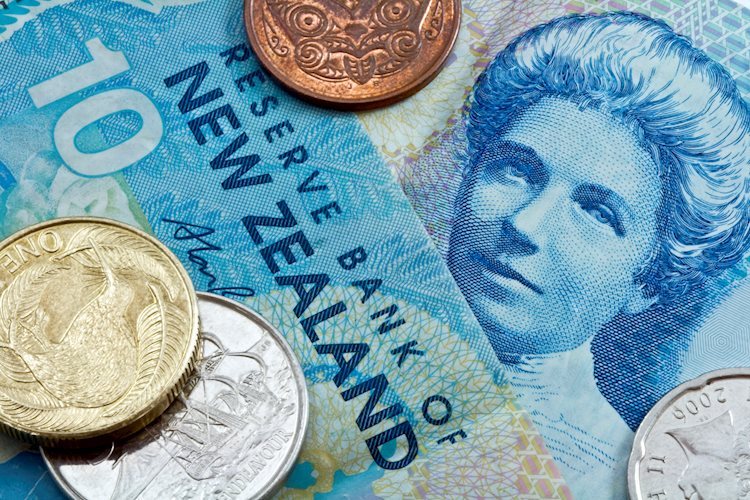- NZD/USD has marked a nine-month high of 0.6355 on Wednesday.
- The New Zealand Dollar gains ground as the largest export partner China has injected fresh monetary stimulus.
- The US Dollar struggles following a weaker consumer confidence data adding to dovish sentiment surrounding the Fed.
NZD/USD extends its gains for the third successive session, trading around 0.6340 during the Asian hours on Wednesday. The pair marked a nine-month high of 0.6355 earlier in the day. The upside of the New Zealand Dollar (NZD) could be attributed to a stronger outlook for foreign currency inflows amid fresh monetary stimulus by New Zealand’s largest export partner China.
People’s Bank of China (PBOC) Governor Pan Gongsheng announced on Tuesday that China will reduce the reserve requirement ratio (RRR) by 50 basis points (bps). Gongsheng also noted that the central bank would lower the 7-day repo rate from 1.7% to 1.5%, and reduce the down payment for second homes from 25% to 15%. Additionally, the PBOC cut the one-year Medium-term Lending Facility (MLF) rate from 2.30% to 2.0% on Thursday, following the last reduction in July 2024, when the rate was lowered from 2.50%.
Additionally, the Kiwi Dollar receives support from the stronger purchasing power of neighboring Australians after a hawkish hold by the Reserve Bank of Australia (RBA) lifted the Australian Dollar (AUD). The RBA held the Official Cash Rate (OCR) steady at 4.35% on Tuesday. RBA Governor Michele Bullock also confirmed that rates will remain on hold for now and clarified that a rate hike was not explicitly considered during the meeting.
The US Dollar (USD) received downward pressure following softer-than-expected consumer confidence data from the United States (US) released on Tuesday, which added to dovish expectations for the Federal Reserve (Fed) for its further policy decision. US Consumer Confidence Index fell to 98.7 in September from an upwardly revised 105.6 in August. This figure registered the biggest decline since August 2021.
On Tuesday, Federal Reserve Governor Michelle Bowman stated that key inflation indicators are still “uncomfortably above” the 2% target, urging caution as the Fed moves forward with interest rate cuts. Despite this, she expressed a preference for a more conventional approach, advocating for a quarter percentage point reduction.
New Zealand Dollar FAQs
The New Zealand Dollar (NZD), also known as the Kiwi, is a well-known traded currency among investors. Its value is broadly determined by the health of the New Zealand economy and the country’s central bank policy. Still, there are some unique particularities that also can make NZD move. The performance of the Chinese economy tends to move the Kiwi because China is New Zealand’s biggest trading partner. Bad news for the Chinese economy likely means less New Zealand exports to the country, hitting the economy and thus its currency. Another factor moving NZD is dairy prices as the dairy industry is New Zealand’s main export. High dairy prices boost export income, contributing positively to the economy and thus to the NZD.
The Reserve Bank of New Zealand (RBNZ) aims to achieve and maintain an inflation rate between 1% and 3% over the medium term, with a focus to keep it near the 2% mid-point. To this end, the bank sets an appropriate level of interest rates. When inflation is too high, the RBNZ will increase interest rates to cool the economy, but the move will also make bond yields higher, increasing investors’ appeal to invest in the country and thus boosting NZD. On the contrary, lower interest rates tend to weaken NZD. The so-called rate differential, or how rates in New Zealand are or are expected to be compared to the ones set by the US Federal Reserve, can also play a key role in moving the NZD/USD pair.
Macroeconomic data releases in New Zealand are key to assess the state of the economy and can impact the New Zealand Dollar’s (NZD) valuation. A strong economy, based on high economic growth, low unemployment and high confidence is good for NZD. High economic growth attracts foreign investment and may encourage the Reserve Bank of New Zealand to increase interest rates, if this economic strength comes together with elevated inflation. Conversely, if economic data is weak, NZD is likely to depreciate.
The New Zealand Dollar (NZD) tends to strengthen during risk-on periods, or when investors perceive that broader market risks are low and are optimistic about growth. This tends to lead to a more favorable outlook for commodities and so-called ‘commodity currencies’ such as the Kiwi. Conversely, NZD tends to weaken at times of market turbulence or economic uncertainty as investors tend to sell higher-risk assets and flee to the more-stable safe havens.
Read the full article here

